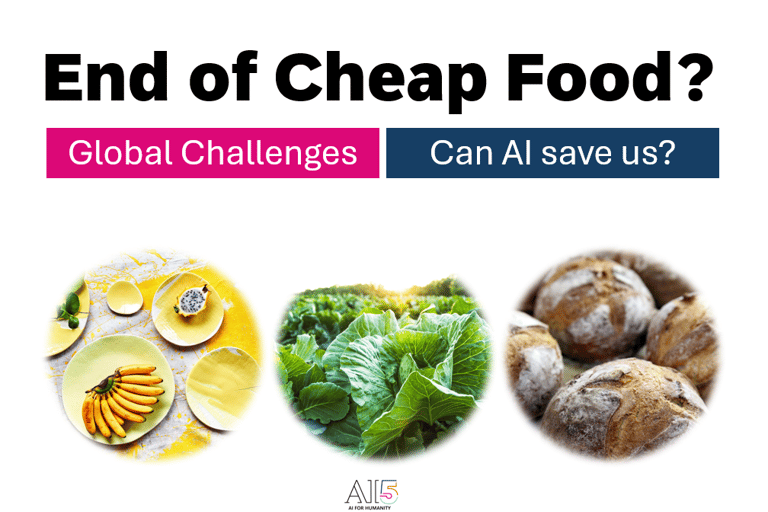Are we close to the end of cheap food? Can AI save us?
Global food prices and the role of AI
AI APPLICATIONS1
Kevin R.
7/13/20252 min read
Food Prices vs. AI Promises:
Can Technology Save Our Tables?
While reading this article on the BBC, I was asking myself ‘Are we really witnessing the end of affordable food?’
As I glance at my grocery receipt, one thing is clear: food prices are up—29.5% since December 2019. Eggs alone are forecasted to jump 33.2% in 2025.
Global experts—from the UN, FAO to others—warn us that rising prices are driven by several persistent forces:
Climate change (droughts, heatwaves)
Pests and disease (e.g., avian flu)
Geopolitical conflict (e.g., Eastern Europe)
Trade and tariff tensions (e.g., Central and North America)
Supply chain breakdowns (e.g., canned goods in 2025)
Essential goods, like eggs, feel more like luxuries today. This goes beyond inflation—it's about food security, household stress, and the deeper question: Can technology, especially AI, really help?
The AI Agriculture Revolution: Real Hope or Just Hype?
AI is full of genuine promise. We're seeing:
John Deere’s autonomous tractors, operating around the clock.
AI-based See & Spray systems that optimise pesticide use.
Google and Microsoft-backed tools offering climate and crop insights to Indian farmers.
Crop management apps like Grain Weevil and Farmonaut improving yields from the US, Australia and China to Pakistan.
Smarter supply chains, using AI to minimise spoilage and improve logistics.
Predictive analytics alone may increase crop yields by 25%. Some reports suggest digital agriculture could boost GDP in low- and middle-income nations by over $450 billion, or 28% per year.
It all sounds impressive and according to some experts, such as Ray Kurtzwil, it is going to get only better. So why are grocery prices still rising?
The Reality Check We Need
Here’s the catch: AI isn’t a silver bullet. It needs major infrastructure, training, and time to scale—especially in farming, where adoption moves slowly.
While AI offers two core benefits—on the acre (farming and livestock) and in the enterprise (business ops)—these gains largely go to large-scale producers who can afford the investment. Most small and medium farmers, who supply a significant portion of global food, are left out.
Moreover, while AI lays the groundwork for a more adaptive, data-driven agricultural system, the road to widespread transformation spans decades.
The Nuanced Answer: Can AI save us?
Yes, because:
It’s precision agriculture reduces waste and optimises inputs
It prevents crop failure with better forecasting
It improves distribution through smart logistics
It helps adapt to climate changes
But also, no, because:
High costs block access for many farmers
The benefits are concentrated among the few
Global food prices are shaped by complex forces beyond production
AI's promise often distracts from needed systemic reforms
What This Means for Leaders
Business leaders must approach AI in agriculture with informed optimism, not blind belief. The technology is real, but impact at scale takes time.
Rather than wait for a tech fix, we must:
Support policies that make AI tools accessible to smallholders
Invest in infrastructure and education for broader adoption
Tackle root causes of food price instability—like supply chain fragility and market power
Recognise that food affordability is a social and economic issue, not just a technical one
The Bottom Line
AI will shape the future of food—but it won’t magically return us to 2019 grocery prices. It's a powerful tool, not a cure-all. To truly address the affordability crisis, we need a mix of innovation, reform, and equitable distribution of benefits.
Until then, the tension between AI promises and grocery realities will remain—reminding us that the future of food depends not only on what we invent, but how we apply it.


© 2024. All rights reserved.



Delivered from
Switzerland
